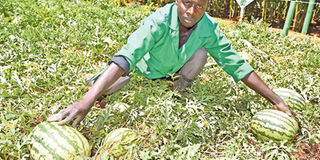Agronomist notebook: What to know as first-time melon farmer

Watermelon plants in a farm. Generally, the fruits take three to four months to mature, depending on the variety and ecological conditions. FILE PHOTO | NATION MEDIA GROUP
What you need to know:
- The spacing of the crop is critical as it grows in vines and spreads on the ground. The spacing from one plant to another should thus be 1.5x1 metre.
- With every plant generating 20 kilos of fruit, a farmer with a quarter an acre piece will get an average yield of seven to eight tonnes of melons.
- Weeding, pest, and disease control should be done before the vines start spreading.
- It is advisable to protect the crop against the insect during the early stages of growth. Traps with pheromones can therefore be used to control the destructive insect and its larvae.
Watermelon is a vine crop that is simple to grow since it requires little maintenance. The fruit has a high water content, increasing its perishability and, therefore, cannot be stored for long.
Alex, a watermelon farmer in Kajiado County, explains how he lost his crops recently. It rained heavily after he had planted the watermelons, resulting in the rotting of the seeds.
In another block of his farm, the mature excess water resulted in the bursting of the fruits. The first nitrogen flash causes the mature watermelon to burst out.
The farmer incurred huge losses because his production and supply to customers was greatly reduced. The crop requires very little water during its entire growth. It is thus mostly grown in semi-arid areas under irrigation.
As the fruit develops, it requires less water. This makes it sweet due to the sugar content and concentration.
The crops require six to eight hours of direct sunlight daily. This helps in the development of the fruit. Excess water causes most newly sowed seeds to rot, drastically reducing the germination rate.
Heavy rain during the vegetative stage is bad for the melon as it causes defoliation. Fungal diseases spread easily.
The spacing of the crop is critical as it grows in vines and spreads on the ground. The spacing from one plant to another should thus be 1.5x1 metre.
The melon can be planted by direct seeding or transplanting after sowing the seeds in a nursery for a month.
It’s advisable to use seedling trays as this ensures the seedlings are transplanted with a lump of soil, resulting in minimal disturbance of the roots.
Generally, fruits take three to four months to mature, depending on the variety and ecological conditions.
Alex the farmer says a plant produces two fruits on average, each weighing eight kilos. A third fruit usually weighs four kilogrammes.
AFFECTS YOUNG FRUITS
It means one plant should generate approximately 20 kilogrammes of fruit. A quarter has a growing surface area of 750 square metres, meaning a farmer will have about 432 watermelon plants on such a piece of land.
Considering the germination rate, a farmer should have on average of 400 plants. With every plant generating 20 kilos of fruit, a farmer with a quarter an acre piece will get an average yield of seven to eight tonnes of melons.
It means one can generate Sh140,000 to Sh160,000 if a kilogramme of watermelon goes for Sh20. To achieve this, the farmer needs to be cautious when growing the melon for the roots should never be disturbed.
The first flowers and fruits of the plant are very critical. That means the farmer should avoid causing mechanical injuries because this leads to fruit and flower abortion. Weeding, pest, and disease control should be done before the vines start spreading.
This helps minimise the mechanical injuries and disturbance to the crop. Timely planting and harvesting is important as this makes the watermelon fetch better prices.
One of the greatest challenges watermelon growers face is the fruit fly. The insect mainly affects young fruits, leading on many occasions to fruit abortion. The larva stage of the fruit fly is the most destructive stage.
The larvae usually tunnel through the fruits. They feed in the fruits, making the young plant to be distorted. The immature fruit eventually falls off.
In some cases, the fruits do not fall but end up deformed. This reduces their value. When water gets into the hole formed by the fruit fly, the melon quickly rots.
It is advisable to protect the crop against the insect during the early stages of growth. Traps with pheromones can therefore be used to control the destructive insect and its larvae.
Affected fruits should be removed and disposed of well as they may still be containing the larvae. Maintaining farm hygiene is important as this reduces the spread of the diseases.





